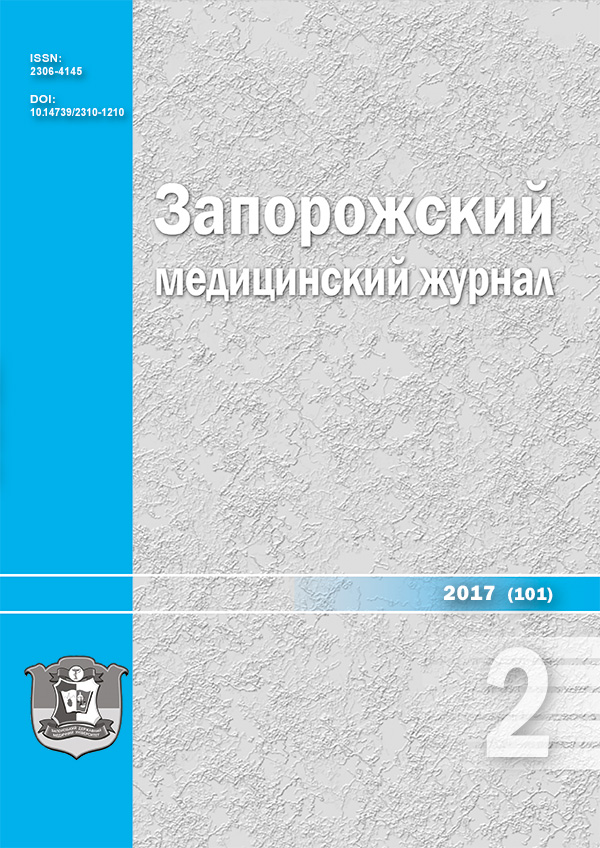Obstetrical and perinatal pathology in women with risk of preterm labor
DOI:
https://doi.org/10.14739/2310-1210.2017.2.95690Keywords:
premature birth, risk of preterm birth, maternal-fetal relationsAbstract
Spontaneous preterm births occurring in 5–13 % of pregnancies are the major cause of perinatal morbidity and mortality, but their frequency has not changed significantly over the past 10 years.
Aim. To make the analysis of the clinical features of pregnancy, childbirth, state of the newborn and fetus in pregnant women with premature birth risk in 22–34 weeks’ gestation and feto-placental complex functional state in pregnant women of this cohort.
Materials and Methods. The analysis of the clinical, laboratory and functional examination results of 121 women has been done. Women were divided into 3 groups: the main group – 43 patients with singleton pregnancy and risk of premature delivery at term 22–34 weeks who received prevention of RDS (dexamethasone 6 mg i. m. № 4 or betaspan 12 mg i. m. № 2), progestogen therapy (utrozhestan 200 mg 1 time a day vaginally) and dalmaksin 200 mg 1 time a day rectally; comparison group – 42 patients also with singleton pregnancy and risk of premature delivery at term 22–34 weeks of gestation who were treated according to the algorithm of the Ukrainian National Guideline № 624 of 03.11.2008; the control group consisted of 36 women with singleton normal pregnancy and delivery which ended with the birth of live full-term newborn.
Results. The average age of the examined patients was 27.08 ± 0.79 years. The average assessment of fetuses STV analysis at 22–34 weeks’ gestation with clinical signs of premature birth risk with the main group was – 11.5 ± 0.98 ms, with the comparison group – 9.8 ± 0.97 ms. No significant differences in uterine-placental-fetal circulation of analyzed groups pregnant women were noted. The average gestational age of the main group newborns was 37.9 ± 2.38 weeks and it was higher than in the comparison group (36.9 ± 4.2 weeks). 23.81 % of comparison group pregnancies ended with a preterm birth, which was significantly higher than in the main group (p < 0.05), where this indicator was 13.95 %. In the structure of perinatal morbidity the leading were: hypoxic-ischemic injury of the CNS with suppression syndrome, neonatal jaundice, respiratory distress syndrome type I, intraventricular hemorrhages, and retinopathy of prematurity.
Conclusions. Using for premature birth risk treatment utrozhestan 200 mg 1 time a day vaginally, dalmaksin 200 mg 1 time a day rectally reduces the risk of preterm birth rate and improves physiological condition of pregnancy and fetus. The effectiveness of the premature birth risk treatment of the main group patients shows not only the improvement of this complication clinical symptoms and satisfactory functional state of feto-placental complex, but also reduction the percentage of early preterm birth, and as a consequence, decrease in severe perinatal morbidity.
References
Spiridonova, N. V., & Melkadze, E. V. (2013) Sostoyanie novorozhdennyсh u zhenschin pri prezhdevremennykh rodakh v zavisimosti ot nalichiya ugrozy preryvaniya beremennosti v I, II, III trimestrakh gestacii [State of newborn in women with preterm birth depending on the presence of threatened abortion in I, II, III trimester of gestation]. Mat´ i ditya Proceedings of the XIV All-Russian Scientific Forum. (P. 461–462), Moscow. [in Russian].
Savel´eva, G. M., Shalina, R. I., Kurcer, M. A., Klimenko, P. A., Sichinava, L. G., Panina, O. B., et al. (2012) Prezhdevremennye rody, kak vazhnejshaya problema sovremennogo akusherstva [Preterm labor as the most important problem of modern obstetrics]. Akusherstvo i ginekologiya, 8(2), 4–10 [in Russian].
Zhabchenko I. (2012) Profilaktika prezhdevremennykh rodov: sovremennye organizacionnye i lechebnye vozmozhnosti [Prophylaxis of preterm birth: modern properties of organization and treatment]. Z turbotoiu pro zhinku, 8, 69–71 [in Ukrainian].
Drukker, N. A., Zenkina, Z. V., Nekrasova, M. G., Kryimshokalova, Z. S., & Anikeva, N. M. (2013) Osobennosti iniciacii prezhdevremennykh rodov na fone sistemnogo narusheniya metabolizma [Features of initiation of preterm labor on the background of systemic metabolic disorders]. Mat´ i ditya Proceedings of the XIV All-Russian Scientific Forum. (P. 57), Moscow. [in Russian].
Hychka, N. M. (2016) Udoskonalennia diahnostychno-terapevtychnykh zakhodiv pry zahrozi intranatalnoho poshkodzhennia nedonoshenoho ploda (Avtoref. dis…kand. med. nauk). [Improving of the diagnostic and therapeutic actions at risk of intrapartum damage of premature delivered fetus]. Extended abstract of candidate’s thesis). Lviv [in Ukrainian].
Ferguson, K. K., McElrath, T. F., Chen, Y. H., Loch-Caruso, R., Mukherjee, B., & Meeker, J. D. (2015) Repeated measures of urinary oxidative stress biomarkers during pregnancy and preterm birth. Am J Obstet Gynecol., 212(2), 208.e18. doi: 10.1016/j.ajog.2014.08.007.
Ganer Herman, H., Miremberg, H., Dekalo, A., Barda, G., Bar, J., & Kovo, M. (2016) Preterm uterine contractions ultimately delivered at term: safe but not out of danger. Eur J Obstet Gynecol Reprod Biol., 199, 1–4. doi: 10.1016/j.ejogrb.2016.01.019.
Sentilhes, L., Sénat, M. V., Ancel, P. Y., Azria, E., Benoist, G., Blanc, J., et al. (2016) Prevention of spontaneous preterm birth (excluding preterm premature rupture of membranes): Guidelines for clinical practice - Text of the Guidelines. J Gynecol Obstet Biol Reprod (Paris), 8, pii: S0368-2315(16)30112-0. doi: 10.1016/j.jgyn.2016.09.011.
Navathe, R., & Berghella, V. (2016) Progesterone as a tocolytic agent for preterm labor: a systematic review. Curr Opin Obstet Gynecol, 28(6), 464–469. doi: 10.1097/GCO.0000000000000327.
Azria, E. (2016) The use of progestatives for the prevention of spontaneous preterm birth. J Gynecol Obstet Biol Reprod (Paris), 45(10), 1280–1298. doi: 10.1016/j.jgyn.2016.09.012.
Downloads
How to Cite
Issue
Section
License
Authors who publish with this journal agree to the following terms:
Authors retain copyright and grant the journal right of first publication with the work simultaneously licensed under a Creative Commons Attribution License that allows others to share the work with an acknowledgement of the work's authorship and initial publication in this journal. 

